|
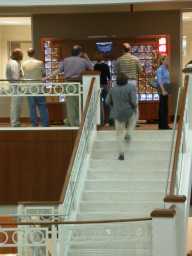
Periodic Table Display at DePauw University
Home
This is a short story by Theodore Gray about the installation of the Periodic Table Display at DePauw University.
Max Whitby and I recently built a
periodic table display for the fancy
new Julian Science and Mathematics Center at DePauw University in Indiana.
They seem to like it.
In the coming weeks we will provide a comprehensive website that will allow exploration of the entire display in depth,
as well as provide detailed information about and photographs of each individual sample.
In the meantime, you can find a selection of photographs on these pages that provide an initial glimpse of the installation.
You can also visit my main periodic table website which includes detailed
descriptions of many of the same kinds of samples, though it has many more than could be included in any individual display.
(Click any picture to see a large version opened in a new window.)
 The display is 10 feet wide and 7 feet tall and boy is it beautiful. Normally I would build something like this (not that there is anything
else quite like this) out of white oak and/or walnut, but the Julian center's atrium has a lot of very nice cherry wood panelling, and I thought
it would be good for our display to fit in. We got a gallon of the matching stain from them and our ace carpenter/historian Colin McCoy and I
built the cabinet out of cherry.
The display is 10 feet wide and 7 feet tall and boy is it beautiful. Normally I would build something like this (not that there is anything
else quite like this) out of white oak and/or walnut, but the Julian center's atrium has a lot of very nice cherry wood panelling, and I thought
it would be good for our display to fit in. We got a gallon of the matching stain from them and our ace carpenter/historian Colin McCoy and I
built the cabinet out of cherry.
To see the display in its cherry-rich environment, view the high (5.8MB) or
low (1.4MB) resolution QuickTime VR panorama (requires QuickTime viewer).
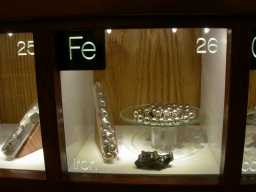 Each element has its own six inch cube, and one of the most remarkable things about the display is the lighting: Five super-bright LEDs per cube,
mounted on circuit boards designed by Max and individually aimed to highlight the particular samples.
Each element has its own six inch cube, and one of the most remarkable things about the display is the lighting: Five super-bright LEDs per cube,
mounted on circuit boards designed by Max and individually aimed to highlight the particular samples.
As we had hoped, up close this gives very much the impression of a hundred separate displays, rather than one display with a hundred parts. In many cases the
multiple shadows cast by the micro-spotlights are quite attractive in their own right. This is something that would have been nearly
impossible just a few years ago: Prior to the invention of super-bright LEDs the only option would have been fiber optic illumination, a cabling nightmare.
Even a year or two ago the price of super-brights would have been prohibitive, but today they are well
within the budget for this kind of display.
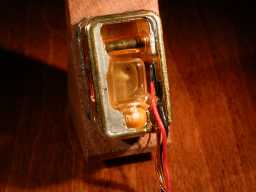 Many of the objects have been selected for their beauty as much as for their elemental content. This rubidium time standard cell contains only
a tiny speck of rubidium sealed in the rectangular glass capsule, but it is an interesting application of rubidium (of course we also include a
larger vial of pure rubidium to show off its bulk properties).
Many of the objects have been selected for their beauty as much as for their elemental content. This rubidium time standard cell contains only
a tiny speck of rubidium sealed in the rectangular glass capsule, but it is an interesting application of rubidium (of course we also include a
larger vial of pure rubidium to show off its bulk properties).
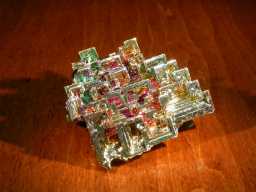 Many visitors will have heard of cesium and rubidium time standards, but how many people
have actually seen what such a time standard looks like?
This bismuth crystal is an ideal sample because it's not only beautiful, it's also made out of a substantial quantity of 99.99% pure bismuth metal. In fact, crystals like
this can only be made with very high purity bismuth, an interesting fact that is explained in the computerized information page for this element.
Many visitors will have heard of cesium and rubidium time standards, but how many people
have actually seen what such a time standard looks like?
This bismuth crystal is an ideal sample because it's not only beautiful, it's also made out of a substantial quantity of 99.99% pure bismuth metal. In fact, crystals like
this can only be made with very high purity bismuth, an interesting fact that is explained in the computerized information page for this element.
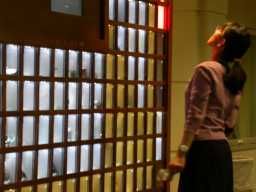 From up close, what you notice most is the brightly-lit samples and the nice wood backgrounds behind them (a different kind of wood for each
chemical group). But we wanted the display to be attractive from a distance too, both because it is visible from all over all three levels of
the atrium, and because we wanted it to beckon people to come closer. From the sides, the most striking thing is the alternating warm-white
and cool-white illumination, based on chemical groups just like the wood backgrounds. (Super-bright LEDs are now available in a wide range
of color temperatures, as well as in both spot and flood configurations, allowing nearly limitless flexibility of lighting.)
From up close, what you notice most is the brightly-lit samples and the nice wood backgrounds behind them (a different kind of wood for each
chemical group). But we wanted the display to be attractive from a distance too, both because it is visible from all over all three levels of
the atrium, and because we wanted it to beckon people to come closer. From the sides, the most striking thing is the alternating warm-white
and cool-white illumination, based on chemical groups just like the wood backgrounds. (Super-bright LEDs are now available in a wide range
of color temperatures, as well as in both spot and flood configurations, allowing nearly limitless flexibility of lighting.)
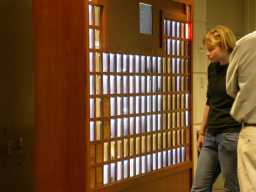 The amount of light coming from the 600 LEDs in the display is enough to light up people in front of it: This high level of lighting
is important to bring the samples out into the room, the same way a well-lit shop window seems to be part of the street more so
than it is part of the building it is in. The Lucite panels in front virtually disappear, largely because of the quality of
illumination.
The amount of light coming from the 600 LEDs in the display is enough to light up people in front of it: This high level of lighting
is important to bring the samples out into the room, the same way a well-lit shop window seems to be part of the street more so
than it is part of the building it is in. The Lucite panels in front virtually disappear, largely because of the quality of
illumination.
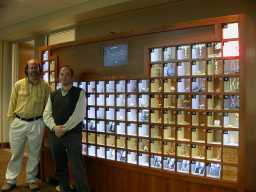 The computer screen in the middle is a 17" iMac hidden in a shelf above the transition metals. It is connected to a sophisticated set of relays
and touch sensors built by Max. Aside from displaying element information and beautifully-shot videos for many elements (Max is, after all,
a film producer by trade), the computer is able to turn on and off the LEDs for individual cubes, as well as controlling the noble gas tubes,
the mercury stirring, the europium-doped compact fluorescent light, and other elements (ha, ha) of the display.
The computer screen in the middle is a 17" iMac hidden in a shelf above the transition metals. It is connected to a sophisticated set of relays
and touch sensors built by Max. Aside from displaying element information and beautifully-shot videos for many elements (Max is, after all,
a film producer by trade), the computer is able to turn on and off the LEDs for individual cubes, as well as controlling the noble gas tubes,
the mercury stirring, the europium-doped compact fluorescent light, and other elements (ha, ha) of the display.
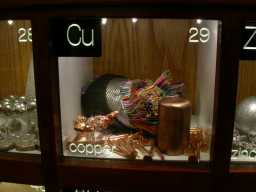 A common problem with element displays is that about 90% of all elements are gray metals. Displays consisting of
many dozen lumps of gray metals have a certain lack of appeal to the non-chemist. And frankly, I think of lot of chemists
find them pretty boring too. So Max and I put a lot of effort into finding interesting shapes, textures, and forms of pure
elements, as well as examples of common and uncommon commercial products that use elements in interesting ways. The copper cube,
for example, contains a cylinder of pure copper, but also copper roofing nails and a 3000-wire telephone cable, along with a small
sample of native (naturally occurring) pure copper from the Lake region of Michigan.
A common problem with element displays is that about 90% of all elements are gray metals. Displays consisting of
many dozen lumps of gray metals have a certain lack of appeal to the non-chemist. And frankly, I think of lot of chemists
find them pretty boring too. So Max and I put a lot of effort into finding interesting shapes, textures, and forms of pure
elements, as well as examples of common and uncommon commercial products that use elements in interesting ways. The copper cube,
for example, contains a cylinder of pure copper, but also copper roofing nails and a 3000-wire telephone cable, along with a small
sample of native (naturally occurring) pure copper from the Lake region of Michigan.
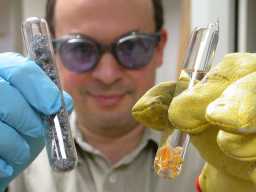 Our customer, the Chemistry Department of DePauw University, seems very pleased with their new display. We are indebted to Bridget Gourley,
Bryan Hanson, and Dave Roberts in particular: They were
extremely helpful in giving us access to an entire large and brand-new chemistry laboratory.
Our customer, the Chemistry Department of DePauw University, seems very pleased with their new display. We are indebted to Bridget Gourley,
Bryan Hanson, and Dave Roberts in particular: They were
extremely helpful in giving us access to an entire large and brand-new chemistry laboratory.
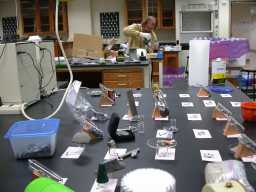 We got to put the very first scratches
on the shiny new lab tables, and spill the first toxic chemicals in the spiffy new fume hoods. How often do you get a chance to do that!
(Max is shown here holding arsenic and white phosphorus.)
We got to put the very first scratches
on the shiny new lab tables, and spill the first toxic chemicals in the spiffy new fume hoods. How often do you get a chance to do that!
(Max is shown here holding arsenic and white phosphorus.)
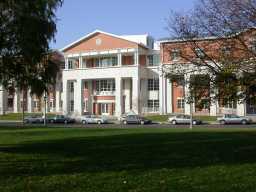 The Julian center is dedicated, and was at the end of our stay re-dedicated, to Percy Julian the great organic chemist. His daughter gave
an inspiring talk at the lunch, and I think our display lives up to the high standards both of the building and of the man it is dedicated to.
The Julian center is dedicated, and was at the end of our stay re-dedicated, to Percy Julian the great organic chemist. His daughter gave
an inspiring talk at the lunch, and I think our display lives up to the high standards both of the building and of the man it is dedicated to.
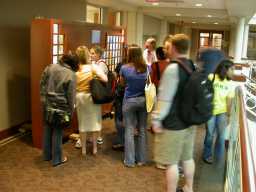 The response to the display by DePauw University undergraduate students has been quite remarkable. Their first response was nearly universal
astonishment at the simple beauty of the object: This is an aspect I had hoped for, but never imagined could be achieved at the level
it seems to have been. And as hoped, nearly everyone who walks by for the first time is drawn in to study individual elements more
closely. (The wooden frame dividing the elements is designed to encourage consideration of each element as a separate, unique entity
in its own right, and this appears to have been a success.)
The response to the display by DePauw University undergraduate students has been quite remarkable. Their first response was nearly universal
astonishment at the simple beauty of the object: This is an aspect I had hoped for, but never imagined could be achieved at the level
it seems to have been. And as hoped, nearly everyone who walks by for the first time is drawn in to study individual elements more
closely. (The wooden frame dividing the elements is designed to encourage consideration of each element as a separate, unique entity
in its own right, and this appears to have been a success.)
We are interested in building more of these installations at other universities, museums, science centers and corporations,
and have set up company and supply chain structures to facilitate this.
If you would like to discuss this possibility, email Max Whitby (max@rgbco.com).
You can reach him in the UK at +44 (0)20 7490 1788 or fax +44 (0)20 7251 0588.
Home
|
|
|